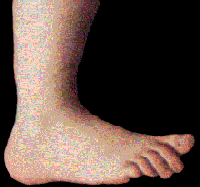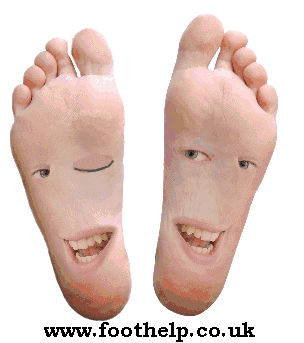Verrucae Pedis (Click Here for Latest Excellent Idea)
What are they?
Verruca is the Latin
term for ‘Plantar Wart’. Simply a lump of hard skin which DOES NOT grow
inwards but is “flattened” by the action of walking.
How are they spread?
The verruca is caused
by a virus infecting the skin. It is not understood exactly how they are
spread. In the past it was argued that, there was more chance of getting
a verruca where barefoot activities are taking place (however this has
never been scientifically proven). This DOES NOT mean that everyone going
swimming will eventually get a verruca, and thankfully many pools have
put signs up stating that it is acceptable to enter the pool even if you
have a verruca. This will help remove some common myths surrounding the
verruca.
Treatment
Most verruca are NOT
painful, and if left alone will eventually disappear. There is plenty
of evidence to show that, once they have cleared ‘naturally’ an increased
immunity to
further infection
is conferred. Those which are painful, often are only so due to being
“messed with”, or being pinched by footwear. If it is felt the discomfort
is too much to bear, or the verruca is taking much too long to disappear
naturally, it can be treated effectively by a chiropodist. Zinc
Tablets have been shown since 2017 to be a worthwile remedy to try
- Click
here
Commonly treatments usually involve the use of chemicals, and/or machines
to freeze or burn the part. Although the method used will be adapted by
all practitioners to be as kind and quick as is possible, removing a verruca
is often lengthy, expensive, and painful. HOME TREATMENT is dangerous
and inadvisable. Most verrucae that I have actually had to treat, had
been damaged by some product sold over a chemist counter (a situation
that has got worse since the mid 1990’s when the restrictions on television
advertising of these weak toxins were lifted).
What does one usually
look and feel like?
A slightly raised hard
round yellow lump with a crusty white middle containing black dots. If
pressed upon no discomfort is felt, but it is very painful if pinched.
Usually there is only one or two ‘blobs’ and most people are unaware of
them until pointed out. They can be more sensitive first thing in the
morning, when hot, and after exercise, when a sharp twinge is noticed
as the heart pounds. Sometimes a few centimetres of skin is affected by
a different verruca virus causing a ‘Mosaic Wart’, this type is particularly
resistant to treatments.
Private Swimming Pools,
and Children
Sometimes owners of premises
outside state control insist that “verruca socks” are worn. Whilst there
is no evidence these work, they can alley the prejudice of others. (Care
should be taken as they can cause slipping - if only one foot is affected
only wear one sock).
Reasons For Treatment.
Usually
the reason a Chiropodist will agree to treat a verruca is:
1)
The verruca has been “messed with” already, either by the application
of ‘wart cures’ in the home, or unqualified practitioners having damaged
the skin, and it is felt the bodies defences consequently have
been compromised.
2) Social pressures upsetting the patient, commonly in the form of victimisation,
often hearsay & the prejudice of other people stops the person following
a ‘normal’ lifestyle, i.e. believing they are prevented from swimming.
3) If the verruca is on a part of the foot that means it regularly gets
pinched, and the discomfort is constant.
4) Systemic medical problems that mean the patient is unable to deal with
this minor infection naturally.
5) The infection appears to be seriously spreading (although this is usually
due to one or more of the reasons above).
IDEALLY
LEAVE THE VERRUCA ALONE! THIS CANNOT BE EMPHASISED ENOUGH
However if
a more radical method actually is requested, there are several factors
to be taken into consideration:
a) How quickly the verruca needs to be cleared up. b) The medical history
and current health of the patient. c) Whether a scar left afterwards would
be a problem. d) If previous treatment attempts prevent hope of success
now. e) How sensitive is - the patient/that part of the foot. f) Cost.
Inescapable
Consequences of Treatment
If you are
trying to kill a bit of skin containing a verruca it will hurt! Our skin
is full of nerves which will be extra sensitive, especially if the part
is or has been cut away or damaged by a chemical.
The only trade off we can do is cause a little pain over several weeks,
or cause a great deal of pain for a day or two. Analgesics, and anaesthetics
may only be helpful in reducing suffering.
There is no treatment guaranteed to work, and having a verruca treated
once unsuccessfully makes it considerably more difficult to get any other
method to work in the future, so if treatment must be done choosing the
right one first time is critically important.
Very Common
Treatment Procedures in the UK
Cryotherapy
The verruca is frozen twice, a pad made to keep the pressure off afterwards.
(I sometimes will still offer this old-fashioned treatment when clinically
indicated). Each treatment is finished the day you come, but may need
repeating not sooner than 6 weeks again.
Strong Acid Based Ointments Put inside a pad onto the verruca,
kept in place and dry for one or more weeks, when you return to the surgery
I remove the pad and wart or repeat the treatment. Pain at home during
this treatment is often much relieved by elevating the part and taking
an analgesic, but rarely is there discomfort in the surgery. This commonly
used method always requires you return to the practice on the appointment
day booked. Often it will take two to six weeks of treatments to work.
Liquid Caustics Applied to the verruca directly. This is an accurate
but lengthy, therefore expensive, treatment. It is usually painful during
applications at the surgery, but less of a problem at home and work. It
can easily take several months of applications twice a week.
Surgical and Electrical Sometimes an ideal treatment for adults,
although it does require a local anaesthetic, and can leave scar’s.
Home (Bought from Chemist) Acid Treatments Every patient I have
seen try these has had no success, found they caused harm, or if the wart
went, success is easily attributed to the body having cured itself (which
happens all of the time and almost always it would be better to let the
body cure these themselves anyway).
Less Common
Treatment Procedures in the UK
Herbal Remedies
A simple application of a concentrated plant extract after removal of
the overlying hard skin can be an ideal treatment especially for a very
nervous patient, or someone who does not mind waiting a little longer
for a resolution.
Immune Response Triggering This procedure I seem to be using
more and more, it does involve a little discomfort in the surgery but
has such clear benefits above most other treatments that often make it
a first choice where a professional intervention is indicated.
SUMMARY:
I hope you have not been frightened by this leaflet, but I aim to answer
most questions people are reluctant to ask. The trends have changed over
the years, in 1979 I treated over half of the patients seen with verrucae,
from 1993 until 2004 I treated on average just two verrucae each year,
so the prejudice making people want to treat them has been slowly disappearing
against them. By 2011 (when I last updated this page) I appear
to be treating about one in eight verrucae that I see, most often using
an "Immune Response Trigger" method rather than any other choice.
Seven out of eight people I see choose to let the verrucae eventually
go themselves untreated.
KNOWN FACT - 75% of
all verrucae clear themselves in under 2 years.
KNOWN FACT - 33% of warts tested also had the virus in tissue 5-10cm away
from the hard skin lump (coincidentally KNOWN FACT - 33% of all independent
researched “successful” treatments had new regrowths 1 year later).
Produced by: Jonathan D. Lees D.Pod.M., M.R.C.Pod.
Telephone: Stourbridge (01384) 390000
Surgery Address: 37 High Street, Amblecote, Stourbridge, West Midlands DY8 4DG











